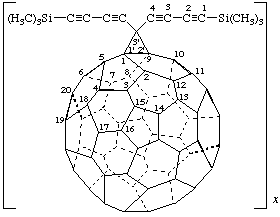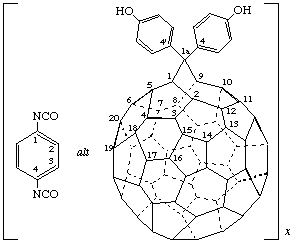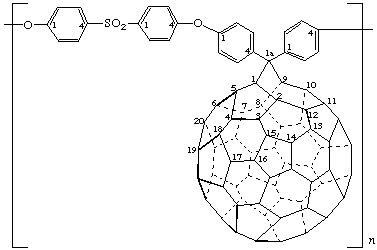
Poly{[3'H-cyclopropa[1,9](C60-Ih)[5,6]fullerene-3',3'-diyldibuta-1,3-diyne-4,1-diyl]bis(trimethylsilane)}
(a source-based name)
Examples:
Note: There are no specific IUPAC recommendations for drawing source-based polymer structures. The structures in this section follow conventions adopted by CAS.I A homopolymer.

Poly{[3'H-cyclopropa[1,9](C60-Ih)[5,6]fullerene-3',3'-diyldibuta-1,3-diyne-4,1-diyl]bis(trimethylsilane)}
(a source-based name)
II A copolymer.

Poly[ethane-1,2-diamine-co-(C60-Ih)[5,6]fullerene]
(a source-based name)
III An alternating copolymer.

Poly[4,4'-1aH-1(9)a-homo(C60-Ih)[5,6]fullerene-1a,1a-diyldiphenol-alt-1,4-diisocyanatobenzene]
(a source based name)
IV A polymer constitutional repeating unit (CRU)

Poly[oxy-1,4-phenylenesulfonyl-1,4-phenyleneoxy-1,4-phenylene-
-1aH-1(9)a-homo(C60-Ih)[5,6]fullerene-1a,1a-diyl-1,4-phenylene]
(a structure-based name)
14. International Union of Pure and Applied Chemistry. Macromolecular Division. Commission on Macromolecular Nomenclature, "Source-Based Nomenclature for Copolymers (Recommendations 1985)". Pure Appl. Chem. 1985, 57, 1427-1440; Reprinted as Chapter 7 in Compendium of Macromolecular Nomenclature, W. V. Metanomski, ed., Blackwell Scientific, UK, 1991.
15. International Union of Pure and Applied Chemistry. Macromolecular Division. Commission on Macromolecular Nomenclature, "Nomenclature of Regular Single-Strand Organic Polymers (Rules Approved 1975)". Pure Appl. Chem. 1976, 48, 373-385; Reprinted as Chapter 5 in Compendium of Macromolecular Nomenclature, W. V. Metanomski, ed., Blackwell Scientific, UK, 1991, Chapter 7.